Table of Contents
Rheumatoid arthritis (RA) is a common problem that affects at least 1.5 million Americans.
It can cause severe joint pain, swelling, stiffness, and an inability to function normally.
However, there are plenty of common health problems that can cause similar symptoms.
For this reason, it is important to understand how to identify RA.
Do You Have RA?
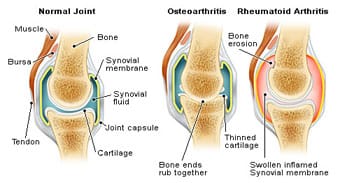 In most cases, the onset of RA begins in a symmetrical pattern, affecting both sides of the body.
In most cases, the onset of RA begins in a symmetrical pattern, affecting both sides of the body.
Many doctors view this as one of the primary differentiators between RA and other medical problems.
It is possible for certain joints to hurt worse than others, but they should hurt symmetrically.
Research has also shown that RA can be somewhat genetic.
Identical twins have been shown to have the potential to develop RA, but are not guaranteed to be diagnosed.
It is believed that having the right genes are need to contract RA, but that merely having these genes does not guarantee contracting RA.
Therefore, RA can be driven by both environmental factors and a person’s genetic code.
If someone in your family has RA and you are experiencing joint pain, there may be an elevated risk for family.
The most important thing to remember is that RA can be stopped if it is treated early.
As time goes on, RA will get worse with each passing day.
However, a combination of medicine and dieting can cause RA to go into remission.
If you have any of the rheumatoid arthritis symptoms listed below, get in touch with your doctor to get tested for RA.
Once you have identified the problem, you can start taking immediate action to start fighting back.
Do I Have RA? Understanding Symptoms Associated With Early Onset
The first thing you will need to do is evaluate your own body.
You can do this yourself, or with the assistance of someone you trust.
If your symptoms do not prevent you from being able to write, make a list of each area that hurts, what kind of pain you’re experiencing (you can use the 1 to 10 scale) and any other details about the changes you’re experience with your body.
This list can be a valuable asset both for yourself and your doctor.
 Most common symptoms associated with the early onset of Rheumatoid Arthritis:
Most common symptoms associated with the early onset of Rheumatoid Arthritis:
- Hard to heal injuries
- Numbness or tingling in the hands
- Foot trouble
- Eye problems
- Achy joints — often symmetrical
- Morning stiffness
- Locking joints
- Nodules
- Fatigue
If you have concerns that you may have Rheumatoid Arthritis, it’s a great idea to keep a personal journal detailing your symptoms and it is recommended that you work with a professional rheumatologist for the diagnosis.
Tests used to help diagnose Rheumatoid Arthritis
There are various tests that will be conducted including a blood test to determine if you test positive for Rheumatoid Factor.
Rheumatoid factors are a variety of antibodies that are present in 70% to 90% of people with RA.
However, rheumatoid factors can be found in people without RA or with other autoimmune disorders.
Other tests, including X-rays, MRI, ultrasound, and other scans, may be ordered.
These tests are used to help the doctor make an accurate diagnosis.
- Blood Test: the blood test will not provide a definitive answer if you have RA, but it will allow doctors to review:
- rheumatoid factor – check for rheumatoid factor (RF) antibodies that collect in the synovium of the joint. These antibodies are present in about 80% of RA patients
- erythrocyte sedimentation rate (ESR) and C-reactive protein – A high erythrocyte sedimentation rate may indicate inflammation in the joints—as do high levels of C-reactive protein
- complete blood count. This includes hemoglobin and hematocrit tests, which may reveal anemia, an indicator of RA.
- Ultrasound: ultrasound image technology uses imaging to identify inflamed joints. A fast and safe (no radiation exposure) alternative to traditional x-ray analysis of joints
- X-rays: This will show the position of the bones. The x-rays can be used to make measurements of the alignment of the bones and joint spaces.
- Magnetic resonance imaging (MRI) scan:An MRI scan will show the soft tissues, including the ligaments and tendons. MRI scanning can help identify early rheumatoid joint destruction, but it is very expensive and not widely available.
Identifying What Hurts
Neck and Shoulders
 If you have neck or shoulder symptoms there is a good chance that you’re also suffering from headaches and difficulty sleeping.
If you have neck or shoulder symptoms there is a good chance that you’re also suffering from headaches and difficulty sleeping.
It is very important to pay close attention to any neck symptoms.
If you’re experiencing neck stiffness and decreased mobility you should work with your rheumatologist to properly monitor the progression.
Pressure within the spinal column can put the nerves in the spinal column under stress that has the potential to cause more serious problems.
You should visit your doctor if you experience any of these symptoms.
- Headaches
- Tingling or numbness in extremities
- Joint pain and stiffness
- Fatigue
- Limited shoulder mobility
- Trouble Sleeping
Studies have shown that about 63 percent of patients report severe headaches alongside their RA symptoms.
RA-related headaches could be caused by the spreading of pain from other areas, stress, or lack of sleep.
Arms and Elbows
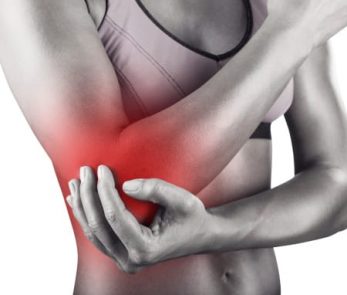 Arthritis in the arms and elbows can be fairly common among RA patients.
Arthritis in the arms and elbows can be fairly common among RA patients.
This pain can be experienced both when bending an elbow and when straightening up an arm.
Even small movements can cause severe pain to be experienced.
Since we need our arms for just about any daily function, arthritis in these areas can be very debilitating.
- Pain on and around the joint
- Swelling
- Instability
- Lack of full movement (unable to extend or flex the elbow)
- Locking
- Stiffness
- Pain in both elbows
Wrists, Hands and Fingers
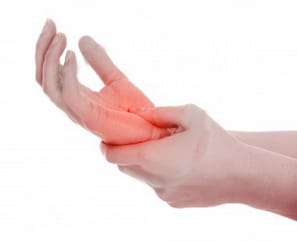 Smaller joints are the common areas that are initially affected by rheumatoid arthritis.
Smaller joints are the common areas that are initially affected by rheumatoid arthritis.
Many people first notice their RA symptoms when a dull pain started to emerge in their wrists and hands.
At first, most patients usually discount the pain as something related to their work environment, driving habits, or daily life.
Unfortunately, this pain will get progressively worse.
- Hand, wrist and finger pain, swelling, and stiffness
- Hand, wrist and finger joints are warm and tender to the touch
- Joints on both sides of the body are affected
- Deformities in finger joints
- Nodules
- Difficulty gripping with hands
- Flu-like feeling
- Fatigue
Since symptoms can be exasperated by your daily habits, it is impossible for these symptoms to be asymmetric.
For example, right-handed individuals are more likely to have increased swelling on their right hand.
If you experience persistent swelling in your hands, it is possible that you could have RA and should contact your physician.
Back and Spine
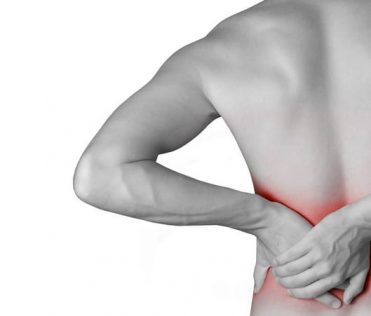 The back and spine are critical to mobility and also potential nerve issues.
The back and spine are critical to mobility and also potential nerve issues.
Since this back pain can get very intense, it is important to start addressing these problems immediately if you experience back pain along with other RA symptoms.
- Local tenderness when the joint of the affected area of the spine is pressed
- Loss of flexibility of the joint(s) in the affected area of the spine
- A crunching feeling when the joint is moved, most often in the neck
- Headaches, related to cervical rheumatoid arthritis
- Pain that radiates down one or both arms, indicating that a cervical spinal nerve root is affected
- Pain that radiates down one or both legs, indicating that a lumbar nerve root is affected
- A change in they way you walk can be a signal that there is increasing pressure on the spinal cord
- Tingling or weakness in the arms or legs, or a loss of coordination or ability to walk
- Difficulty with bowel or bladder control
Back pain can be a very severe and uncomfortable due to the fact that we use our backs constantly throughout the day.
While some people are lucky enough to not experience it, back pain can make typical daily activities very difficult, like getting out of bed, going for a walk, sitting and bending.
If you are starting to experience back pain that is getting worse you should reach out to your doctor.
Hips and Thighs
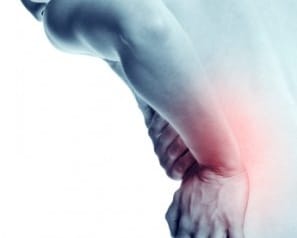 The hip joints are the strongest joints in the entire body.
The hip joints are the strongest joints in the entire body.
As a result, they are remarkably resilient against physical damage and even arthritis.
However, these hip joints are also in perpetual motion for most of our lives.
For this reason, hip tissue can get worn down in the same way that any other joint tissue can.
While hips are not usually the first to start hurting after experiencing RA symptoms, it is not uncommon to have experience hip pain as time with the disease increases.
- Stiffness and discomfort in the joint
- Swelling in the joint
- Achy hip joints — often symmetrical
- Stiffness in the morning
- Locking joints
- Nodules
- Fatigue
Hip pain is common in patients who have had RA for a longer period of time or have not been able to care for their disease.
If you are starting to experience hip pain and you have not been diagnosed with RA, it is not the most common joint for symptoms to appear first, however, to properly diagnose what is causing your hip pain you’ll want to consult with a doctor.
Knees and Lower Legs
 The knees are one of the most common places where RA can initially emerge.
The knees are one of the most common places where RA can initially emerge.
If the pain gets very severe, it can start to work its way down the legs into the upper thighs and lower legs.
RA can start to weaken these joints significantly.
Since these joints have to support the full weight of a person’s body while walking, some people feel RA to start to emerge around the knee caps and in the lower legs.
- Stiffness and discomfort in the joint
- Swelling in the joint
- Achy knees — often symmetrical
- Difficulty walking
- Difficulty bending to sit
- Fatigue
The cartilage around the knees is usually supposed to be covered with synovium lines, which are a form of thin protective tissue.
This tissue secretes a lubricating fluid that makes it easy to walk without bones rubbing against each other.
Unfortunately, RA can start to wear down the synovium lies tissue, causing pain, swelling, stiffness, and fatigue.
Since these problems can completely destroy this joint tissue, most people who experience these knee problems will experience very intense pain that is sustained for a long period of time.
If you have experienced these rheumatoid arthritis pain symptoms for more than a month, you should contact a doctor.
Ankles, Feet and Toes
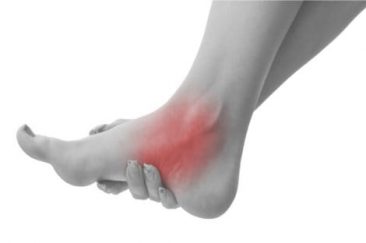 The joints in your feet are often affected in the early stages of rheumatoid arthritis; many people experience pain in the joints at the base of the toes.
The joints in your feet are often affected in the early stages of rheumatoid arthritis; many people experience pain in the joints at the base of the toes.
Tenderness at these joints may cause a person to stand and walk with his or her weight on the heels, with the toes bent upward.
The top of the foot may be swollen and red, and, occasionally, the heel may be painful.
- Joint pain and swelling
- Difficulty with inclines, ramps and stairs due to lack of ankle mobility
- Difficulty walking on uneven ground, grass, or gravel
- Shifting or moving of the foot bones
- Ligaments that support the mid-foot become weakened and the arch collapses
- Nodes and foot deformities
- Bunions
- Claw toe
As with a person’s hands, toes can be very vulnerable to harmful antibodies.
The joints found in toes are some of the smallest joints in the body.
As a result, they are often one of the first areas that hurt when the symptoms of RA start to manifest themselves.
When patients experience these rheumatoid arthritis symptoms, affects on daily activities can include an inability to attend work, unwillingness to get out of bed, and trouble doing domestic chores around the house.
For this reason, foot pain can prevent patients from living a healthy and happy life.
Learn more how to manage the rheumatoid arthritis pain in your ankles, feet and toes.
If you persistently experience this pain, you should get in touch with your doctor right away.
Identify Chronic Pain vs. New Pain
It is important to understand that there is a big difference between chronic pain and short-term pain.
Chronic pain affects patients for a very long period of time. In most cases, chronic pain will not go away without the assistance of a professional doctor.
In former times, chronic pain would sometimes last for an entire lifetime.
In today’s world, there are many solutions for chronic pain that can address the source of the pain or at least reduce the symptoms.
In contrast, short-term pain ends after a finite period of time.
If something hurts today, it may not hurt a week later.
The pains associated with RA can vary by day, but this pain is usually very long-term.
Without taking action to address your RA pain, symptoms will start to get worse.
If you experience joint pain for a significant amount of time, it is important to consider the possibility that you could have RA.
Determine If the Pain Is RA
 Common characteristics to look out for when trying to identify rheumatoid arthritis pain symptoms:
Common characteristics to look out for when trying to identify rheumatoid arthritis pain symptoms:
1. Pains associated with RA are usually chronic, or long-lasting.
2. RA pain is usually symmetrical, meaning that it equally affects both sides of a person’s body.
3. Pain occurring near joints and severe pain after strenuous activity are strong signs of RA.
4. RA pain is usually experienced simultaneously at several locations throughout the body.
5. Severe swelling can often occur in areas that are affected by RA.
If your pain matches the characteristics of at least three of the items listed above, you should make an appointment with a doctor.
